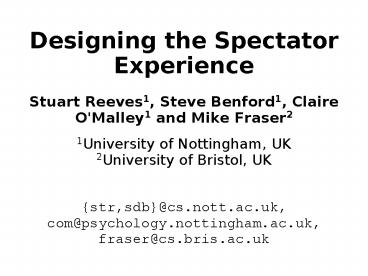Designing the Spectator Experience Stuart Reeves1, Steve Benford1, Claire O'Malley1 and Mike Fraser2 PowerPoint PPT Presentation
1 / 29
Title: Designing the Spectator Experience Stuart Reeves1, Steve Benford1, Claire O'Malley1 and Mike Fraser2
1
Designing the Spectator ExperienceStuart
Reeves1, Steve Benford1, Claire O'Malley1 and
Mike Fraser21University of Nottingham,
UK2University of Bristol, UKstr,sdb_at_cs.nott.
ac.uk, com_at_psychology.nottingham.ac.uk,
fraser_at_cs.bris.ac.uk
2
Introduction
- Interaction is an increasingly public affair
- Museums and galleries, theatres, clubs, the
street - This creates a design challenge for HCI, since we
must start to consider the spectator's experience
of interaction - In contrast, a traditional view on HCI is
participant(s) and machine - Public use of technology challenges this
- We must explore the new relationships that emerge
3
Introduction
- We take a broad view of performance
- Deliberately staged interaction
- Implicit, unwitting performance
- How can we design interfaces for the spectator?
- What can we learn from existing interfaces?
- How can we craft interfaces to produce particular
kinds of experiences as a whole?
4
Components of Performance
- We introduce a triad of elements to describe
interaction of these kinds in a simplified way - Performer the primary user of the interface
- Spectator the primary observer of interface use
- Interface the instrument, device, computer,
etc. that is being used
5
Interaction and Performance
- The performer manipulates the interface, the
spectator experiences these manipulations
6
Interaction and Performance
- The performer manipulates the interface, the
spectator experiences these manipulations - Gestures around interface
7
Unpacking Manipulations
8
Hiding Manipulations
Manipulations of the phone or photo booth
interface are hidden from the spectator
9
Revealing Manipulations
Manipulations of the performers are available and
more legible to the spectator
10
Partially Hiding/Revealing Manipulations
Manipulations of the performer are partially
concealed or hidden from the spectator
11
Amplifying Manipulations
Manipulations of the performer are available and
augmented so as to improve legibility for the
spectator
12
Interaction and Performance
- The performer's manipulations produce effects,
the spectator experiences these effects
13
Interaction and Performance
- The performer's manipulations produce effects,
the spectator experiences these effects - The interface's effects on the performer
14
Unpacking Effects
15
Hiding Effects
The effects created by the performer are hidden
from the spectator
16
Revealing Effects
The effects of performer manipulations are
available to the spectator
17
Amplifying Effects
Effects of performer manipulations are available
and augmented for the spectator
Pianist
Keyboard
18
Putting It Together
19
Populating the Taxonomy
20
Populating the Taxonomy
21
Populating the Taxonomy
22
Populating the Taxonomy
23
Populating the Taxonomy
Populating the Taxonomy
24
Populating the Taxonomy
Populating the Taxonomy
25
Populating the Taxonomy
26
High-Level Design Strategies
27
Further Issues for Spectator Experience
- Interactive spectators how do spectators
interact - Deliberately or
- Accidentally?
- Performer awareness of spectators how do
performers perceive the actions of the spectator?
- Sense of liveness and feedback between
performer and spectator
28
Further Issues for the Spectator Experience
- Transitions and handovers performer and
spectator roles are not static - How do we support the inevitable handing-over of
technology? - Orchestration what about performers
behind-the-scenes?
29
Summary
- The spectator experience is a fundamental part of
interaction - Understanding interaction as consisting of
manipulations and effects - Hidden, revealed, partially hidden/revealed,
amplified - High-level design strategies
- Secretive, expressive, magical and suspenseful

